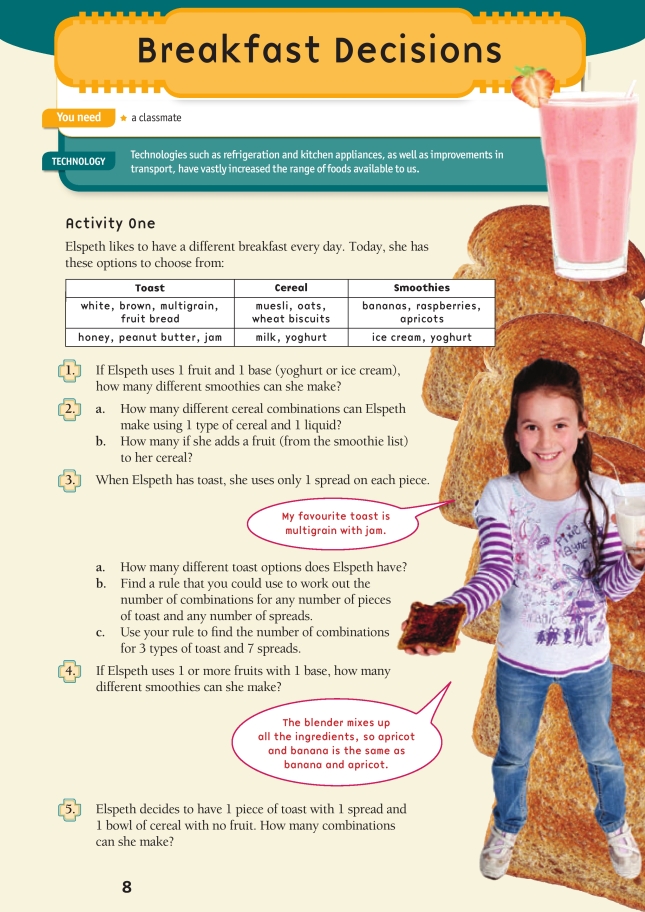Breakfast Decisions
This is a level 3 activity from the Figure It Out series.
A PDF of the student activity is included.
Click on the image to enlarge it. Click again to close. Download PDF (1351 KB)
Making a generalisation involves identifying a pattern and using it to establish a general rule. In these activities, students explore the number of possible breakfasts that can be made using certain ingredients. They should be able to discover a general rule that can be used to find the number of possible combinations for any number of food or drink options. The process of making generalisations is a core component of mathematical reasoning.
FIO, Technology Rules!, Levels 2+-3+, Breakfast Decisions, pages 8 - 9
These activities involve working out possible combinations of breakfasts and calculating the cost of different combinations. As for Skewered Fruit, pages 2–3, the emphasis is on identifying patterns in order to make a generalisation.
The combinations that the students are exploring in Activity One differ from those in Skewered Fruit because the order in which items are combined has no relevance. For example, in Skewered Fruit, a skewer with 2 pieces of kiwifruit and 1 piece of orange can be arranged in 3 different ways (KKO, KOK, OKK). In Breakfast Decisions, a smoothie made with yoghurt and 2 fruits creates a single combination.
The most challenging question in Activity One is question 5. Elspeth is combining toast options with cereal options. Students may intuitively feel that the number of options of each can be added together. This is because we talk about toast AND cereal. However, the actual number of combinations is worked out by multiplying the two values together. For each individual toast option, there are 6 cereal options. As a result, there are 12 x 6 possibilities.
To extend Activity Two, the students could use a supermarket website to find the retail cost of the breakfast items. The students could explore whether the prices Elspeth has chosen are realistic (for a fund-raising activity) and suggest alternative prices if necessary.
Finding and using a model and generalising ideas develops the key competency thinking.
Technology-related student activities
- Interview an older person about food choices and preparation when they were younger. Ask questions about growing food, commercially available ingredients, equipment, taste, and texture.
- Discuss how breakfasts could be produced without using modern technology, for example, bread, juice, and toast. How much longer would it take? What other aspects would be different?
- Plan a fund-raising breakfast. Decide what items to include and how to price them.
- Investigate other cultures’ methods of food production.
Exploring the technology-related context
Access to affordable, reliable technology has enabled people to prepare meals quickly and efficiently. Microwave ovens, toasters, blenders, bread-makers, and juicers have provided people with the ability to produce a wide array of meals. A century ago, many food choices would have required special knowledge and skills and a large amount of time.
Answers
Activity One
1. 6. (3 options with ice cream, 3 with yoghurt: 3 + 3 = 6)
2. a. 6. (2 liquid options for each cereal: 2 x 3 = 6)
b. 18. (For each of the 6 combinations in 2a, there are 3 new combinations: 6 x 3 = 18.)
3. a. 12. (3 spread options for each toast type: 3 x 4 = 12)
b. Number of pieces of toast x number of spreads
c. 21. (3 x 7)
4. 14. (There are 7 fruit options [3 x 1 fruit, 3 x 2 fruits, 1 x 3 fruits] and 2 bases: 7 x 2 = 14.)
5. 72. (There are 12 toast options and 6 cereal options: 12 x 6 = 72.)
6. a. Discussion will vary. Points may include no commercially made products such as muesli and yoghurt, no blenders, no freezers for ice cream, no toasters.
b. Most people tend to stick to one or two breakfast choices and have similar things nearly every day. For example, you might have cereal and fruit and a piece of toast every day, with something different in the weekend.
Activity Two
1. a. $2. ($1 + 2 x $0.50)
b. $3. ($1.50 + 3 x $0.50)
c. $8.50. ($1.50 + $3 + $4)
d. Answers will vary.
2. Answers will vary.

